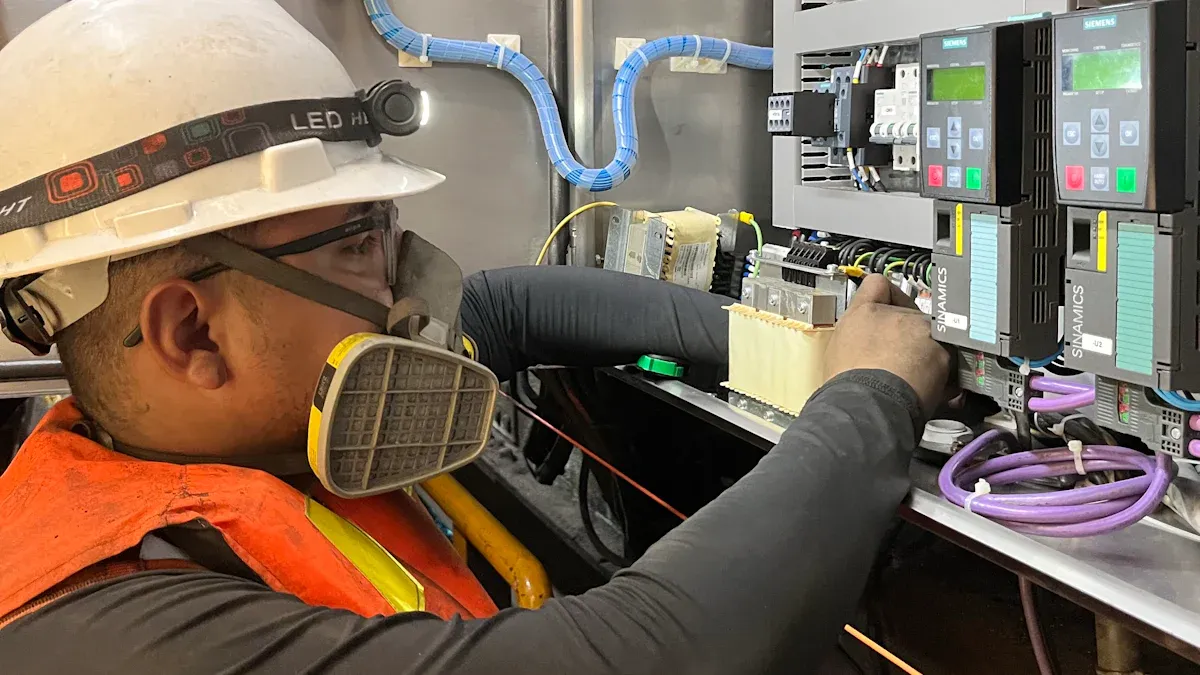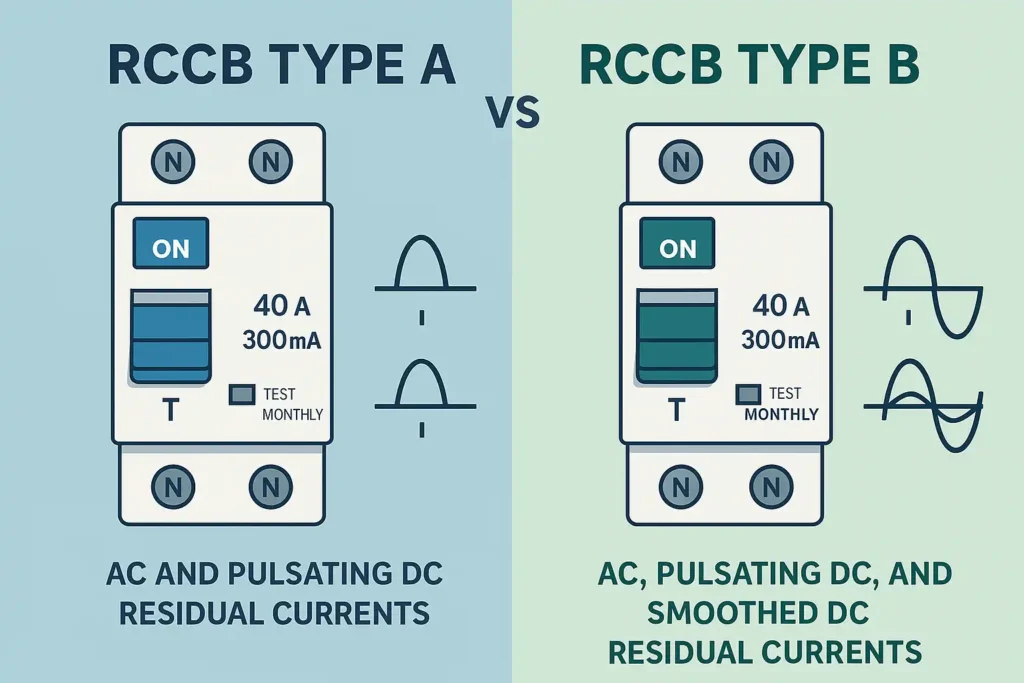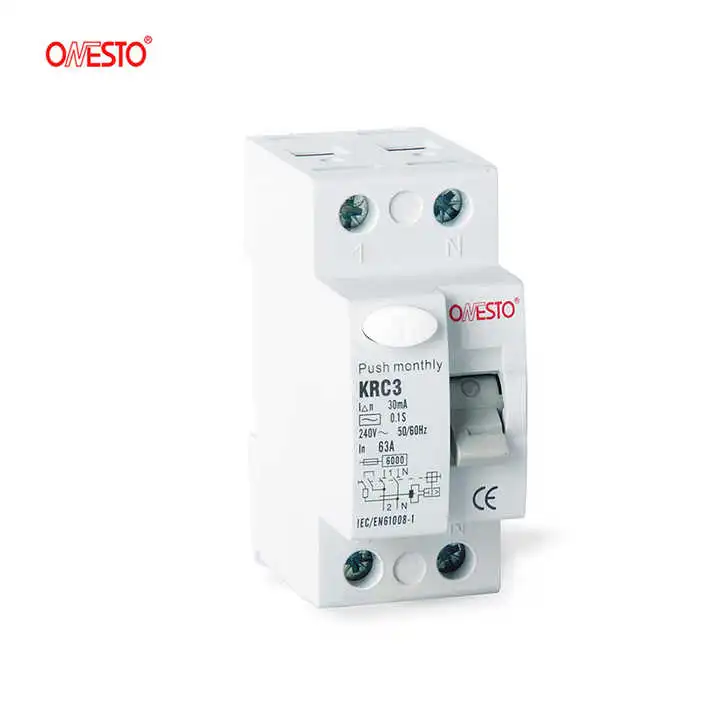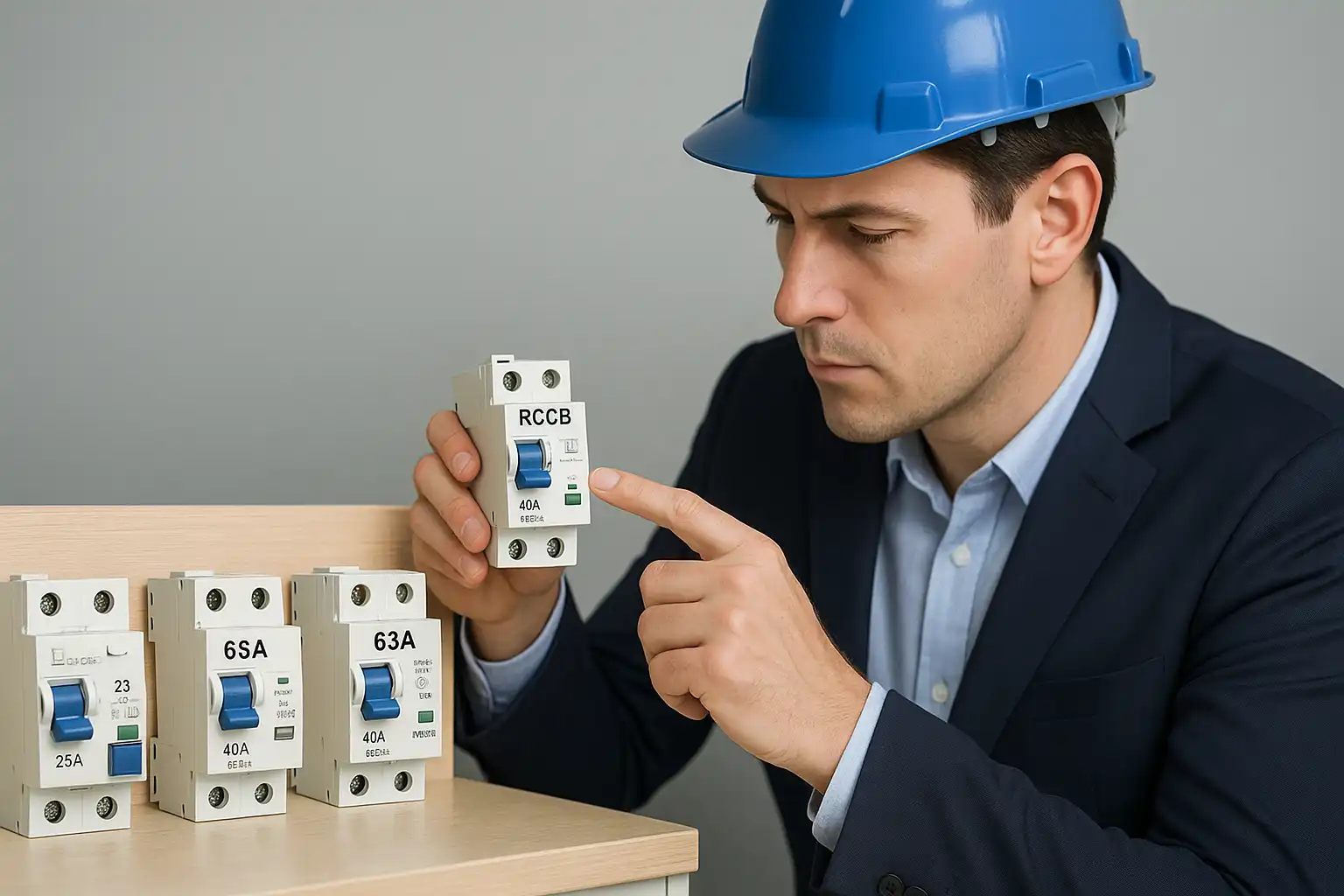When picking Type A or Type B RCCBs, the main difference is what they can detect. Type A RCCBs find alternating currents and pulsing direct currents. This makes them great for homes. Type B RCCBs detect more types of currents, like smooth direct currents. These are better for factories and renewable energy systems.
In houses, 2 Pole RCCBs with lower sensitivity keep people safe. Factories need 4 Pole RCCBs with higher sensitivity (100mA or 300mA). These quickly shut off bad circuits and help prevent fires. Both Type A and Type B RCCBs are important for safe electricity use.
Key Takeaways
- Type A RCCBs work well for homes and small shops. They find alternating and pulsing direct currents, good for modern devices.
- Type B RCCBs are used in factories and solar systems. They detect smooth direct currents, keeping complex systems safe.
- Check the sensitivity level when picking an RCCB. Homes often need 30mA, but factories might need 100mA or 300mA for more safety.
- Test your RCCB often by pressing the test button. This makes sure it works right and protects against shocks and fires.
- Ask a licensed electrician if you’re unsure about the right RCCB. They can help make sure your system is safe and works well.
Overview of RCCBs
What is an RCCB?
An RCCB is a safety device that stops electrical dangers. It watches the flow of electricity in a circuit all the time. If it notices something wrong, it cuts off the power fast. This quick action stops electric shocks and lowers fire risks. RCCBs are very important for keeping homes and workplaces safe from electrical problems.
How RCCBs Ensure Electrical Safety
RCCBs help protect people and electrical systems from harm. They find leaking currents caused by broken wires, bad appliances, or water. When a leak happens, the RCCB shuts off the power right away. This prevents shocks and serious accidents.
Safety rules make sure RCCBs meet strict standards for reliability. They are built to handle different sensitivity levels, like 6mA to 100mA, and current ratings from 16A to 100A. Studies and reports show they work well to stop electrical dangers.
Tip: Test your RCCB often to make sure it works. Most have a test button for this.
Common Types of RCCBs
There are different types of RCCBs for different uses. The main ones are:
- Type AC RCCBs: Find alternating currents only. Good for simple home setups.
- Type A RCCBs: Find alternating and pulsing direct currents. Great for homes with modern gadgets.
- Type B RCCBs: Find alternating, pulsing, and smooth direct currents. Best for factories and renewable energy systems.
Here’s a simple look at RCCB features:
| Specification Type | Description |
|---|---|
| Sensitivity | 6mA, 10mA, 30mA, 50mA, 100mA |
| Current Ratings | 16A, 20A, 25A, 32A, 40A, 63A, 80A, 100A |
| Applications | Protects home devices and wires from leaks and shocks |
RCCBs are used all over the world. More homes now use smart and energy-saving designs. New rules and awareness programs have also made them more popular, especially in houses.
Type A RCCBs
What Type A RCCBs Can Detect
Type A RCCBs find alternating currents (AC) and pulsing direct currents (DC). They watch electricity flow and act fast if something is wrong. This makes them good at spotting issues from modern gadgets like washing machines, LED lights, and induction stoves. These devices often create pulsing DC currents, which Type A RCCBs handle well.
Note: Type A RCCBs cannot find smooth DC currents. For that, use a Type B RCCB.
Where Type A RCCBs Are Used
Type A RCCBs work best in homes and small businesses. They are perfect for houses with advanced gadgets that make pulsing DC currents. Small offices and shops with moderate electrical needs also benefit from them.
Common uses include:
- Protecting circuits for home appliances.
- Keeping lighting systems with dimmers or LED drivers safe.
- Securing electric car chargers (if smooth DC detection isn’t needed).
Good and Bad About Type A RCCBs
Good Points:
- Great at finding AC and pulsing DC currents.
- Cheap and easy to find.
- Simple to set up in homes.
Bad Points:
- Can’t detect smooth DC currents.
- Not fit for factories or renewable energy setups.
When comparing Type A and Type B RCCBs, Type A is cheaper for homes but lacks the advanced features of Type B RCCBs.
Type B RCCBs
What Type B RCCBs Can Detect
Type B RCCBs find alternating currents (AC), pulsing direct currents (DC), and smooth direct currents. They are very useful for advanced electrical systems. These RCCBs can spot earth faults with strong DC parts. This is common in systems with solar panels or electric car chargers.
Studies prove that Type B RCCBs are better at finding high DC currents. Here’s a quick look at the results:
| Study Focus | Findings |
|---|---|
| Earth fault detection with DC components | Type B RCCBs are key for setups with strong DC currents. |
| Sensitivity in DC systems | Type B RCCBs work best in systems with DC sources. |
These features make Type B RCCBs a must-have for modern electrical safety.
Where Type B RCCBs Are Used
Type B RCCBs are great for factories and renewable energy systems. They are used in places with machines that create smooth DC currents. Solar power setups and electric car chargers also need them.
Common uses include:
- Protecting circuits in factories with special machines.
- Keeping solar power systems safe.
- Securing electric car charging stations.
If your system uses DC sources or advanced equipment, Type B RCCBs are the best choice.
Good and Bad About Type B RCCBs
Good Points:
- Finds AC, pulsing DC, and smooth DC currents.
- Works well in big and complex systems.
- Improves safety in factories and renewable energy setups.
Bad Points:
- Costs more than Type A RCCBs.
- Harder to find in some areas.
Type B RCCBs have special features that make them worth the cost. Even though they are less common than Type A RCCBs, they are perfect for tough electrical setups.
Comparing Type A and Type B RCCBs

Detection Capabilities Compared
Type A and Type B RCCBs find different types of currents. Type A RCCBs detect AC and pulsing DC currents. They are great for homes and small offices with modern gadgets like washing machines or LED lights. But they cannot detect smooth DC currents.
Type B RCCBs can detect more. They find AC, pulsing DC, and smooth DC currents. This makes them perfect for factories, solar panels, and systems with heavy machines.
| Feature | Type A RCBO | Type B RCBO |
|---|---|---|
| Detects Residual Currents | AC + Pulsating DC | AC + Pulsating DC + Smooth DC |
| Compliance Standards | IEC 61008/61009 | IEC 62423 |
Tip: Use Type B RCCBs for setups with smooth DC currents.
Applications and Use Cases Compared
Type A RCCBs are best for homes and small businesses. They work well with gadgets that make pulsing DC currents, like fridges, induction stoves, and LED lights.
Type B RCCBs are made for tougher jobs. They are used in factories, solar farms, and electric car chargers. These places often have equipment that makes smooth DC currents, which Type A RCCBs cannot detect.
- Type A RCCBs:
- Homes with modern gadgets.
- Small offices or shops.
- Basic EV chargers (no smooth DC detection).
- Type B RCCBs:
- Factories with big machines.
- Solar power setups.
- Advanced EV chargers.
Note: For renewable energy or factory setups, pick Type B RCCBs.
Cost and Availability Compared
Type A RCCBs cost less and are easy to find. They are simple and work well for most homes.
Type B RCCBs cost more because they do more. They are harder to find in some places but are worth it for complex systems.
| Feature | Type A RCBO | Type B RCBO |
|---|---|---|
| Cost | Lower | Higher |
| Availability | Widely available | Limited in some areas |
Type B RCCBs are expensive but handle advanced systems better.
Reminder: Think about cost and safety before choosing your RCCB.
Choosing the Right RCCB for Your Needs
Factors to Consider When Selecting an RCCB
Picking the right RCCB depends on your electrical setup. First, check the types of currents in your system. If you use solar panels or advanced EV chargers, you’ll need an RCCB that detects smooth DC currents.
Next, think about sensitivity levels. For homes, 30mA sensitivity is common and protects against shocks. In factories, higher levels like 100mA or 300mA help stop fires.
Also, look at the current rating. This tells you how much load the RCCB can handle. For example, a house with many devices might need a 40A RCCB or higher.
Lastly, make sure the RCCB meets safety standards. Look for certifications like IEC 61008 or IEC 62423. These ensure the device is reliable and works well.
Tip: Test your RCCB after installing it to confirm it works.
When to Choose Type A RCCBs
Type A RCCBs are great for homes and small businesses. They work well with gadgets like washing machines, LED lights, and induction stoves. These devices often create pulsing DC currents, which Type A RCCBs can detect.
If you have a basic EV charger that doesn’t make smooth DC currents, Type A RCCBs are a good choice. They are affordable and easy to find, making them perfect for most homes.
Small offices or shops with moderate power needs can also use Type A RCCBs. They are simple to install and provide reliable safety.
Note: Type A RCCBs can’t detect smooth DC currents. Use a Type B RCCB for those systems.
When to Choose Type B RCCBs
Type B RCCBs are made for advanced electrical setups. If you have solar panels, choose this type. Solar systems often create smooth DC currents, which only Type B RCCBs can detect.
Factories and industrial areas also need Type B RCCBs. Machines in these places often produce complex currents, including smooth DC. Type B RCCBs provide strong protection here.
Advanced EV chargers are another use for Type B RCCBs. If your charger makes smooth DC currents, this type is essential for safety.
Though Type B RCCBs cost more, they are worth it for complex systems. They ensure safety in setups where electrical risks are higher.
Reminder: If unsure, ask an electrician to help pick the right RCCB.
Consulting a Professional for Guidance
Picking the right RCCB can be confusing. If you don’t know much about electrical systems, ask an expert. A licensed electrician or engineer can help you choose the safest option. Here’s why their advice matters:
- Understanding Your Needs:
Experts check your system carefully. They figure out the types of currents and the sensitivity levels needed for safety. - Following Safety Rules:
Electrical rules change depending on where you live. Professionals make sure your RCCB meets local safety standards to avoid risks. - Custom Advice:
Experts suggest the best RCCB for your setup. For example, they might recommend a Type B RCCB for solar panels or a Type A RCCB for homes with modern gadgets.
Tip: Always hire licensed electricians. They are trained to handle tricky electrical setups.
Questions to Ask Your Electrician
When talking to an expert, ask questions to understand their advice. Here are some examples:
- Which RCCB works best for my system?
- How do sensitivity levels keep my setup safe?
- Will the RCCB meet local safety rules?
- Can you explain how to install and maintain it?
Note: Asking questions helps you make smart choices. Don’t be afraid to ask for more details.
Benefits of Professional Installation
Experts make sure your RCCB works properly. If installed wrong, it can fail or cause safety problems. Professionals also test the RCCB after installing it to ensure it works well.
- Correct Wiring: They connect the RCCB without mistakes.
- Testing: Experts use tools to check if the device works.
- Confidence: You’ll know your system is safe and reliable.
Reminder: Regular checks by an expert keep your RCCB working perfectly.
When to Seek Professional Help
Call an expert in these situations:
- Installing or upgrading an electrical system.
- Adding solar panels or other renewable energy sources.
- Setting up advanced EV chargers.
- Having frequent electrical problems or tripped circuits.
Getting help from a professional keeps your property safe and protects everyone using the system.
Emoji Tip: 🛠️ Stay safe! Let experts handle tough electrical jobs!
Picking Type A or Type B RCCBs depends on your system. Type A RCCBs are great for homes and small offices. Type B RCCBs work best for factories and renewable energy setups. Both types help stop shocks, fires, and meet safety rules.
Why choosing the right RCCB matters:
| Evidence Type | Description |
|---|---|
| Safety Role | RCCBs find electrical leaks to stop shocks and fires. |
| Regulatory Compliance | Many places require RCCBs for safe electrical systems. |
| Fire Prevention | RCCBs catch faults that could cause fires, lowering risks. |
Think about your needs before deciding. If unsure, ask an electrician for advice to keep your system safe.
Reminder: The right RCCB keeps your home and family safe.
FAQ
1. What happens if I choose the wrong RCCB type?
Picking the wrong RCCB leaves your system unsafe. For instance, Type A RCCBs can’t find smooth DC currents in solar systems. This raises the chance of electrical dangers. Always pick the RCCB that fits your system’s needs.
Tip: Ask an electrician to avoid making expensive errors.
2. Can I install an RCCB myself?
You shouldn’t try installing an RCCB without training. Wrong installation can lead to problems or safety issues. A licensed electrician makes sure it works and meets safety rules.
🛠️ Reminder: Let experts handle electrical work for safety.
3. How often should I test my RCCB?
Test your RCCB once a month. Press the test button to check if it trips properly. Regular tests keep your system safe and prevent failures.
Note: Replace the RCCB if it doesn’t trip during testing.
4. Why are Type B RCCBs more expensive?
Type B RCCBs cost more because they detect more currents, like smooth DC. Their advanced design makes them perfect for solar panels and factory machines.
Emoji Tip: 💡 Spend more for safety in complex systems.
5. Do all homes need an RCCB?
Yes, every home should have an RCCB. It stops electric shocks and lowers fire risks from bad wiring or devices. Even simple setups need this safety tool.
Reminder: RCCBs are essential for safe modern homes.
The following information may be of interest to you
Residual current circuit breaker
How to Select RCCB Sensitivity for Your Home
How to choose a household residual current circuit breaker





